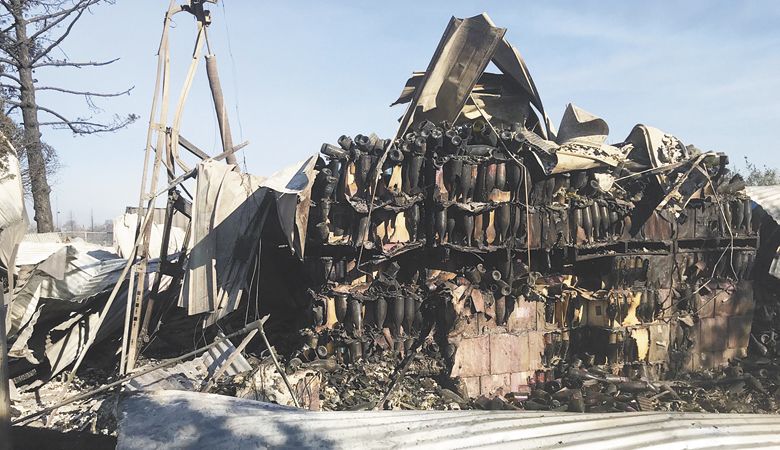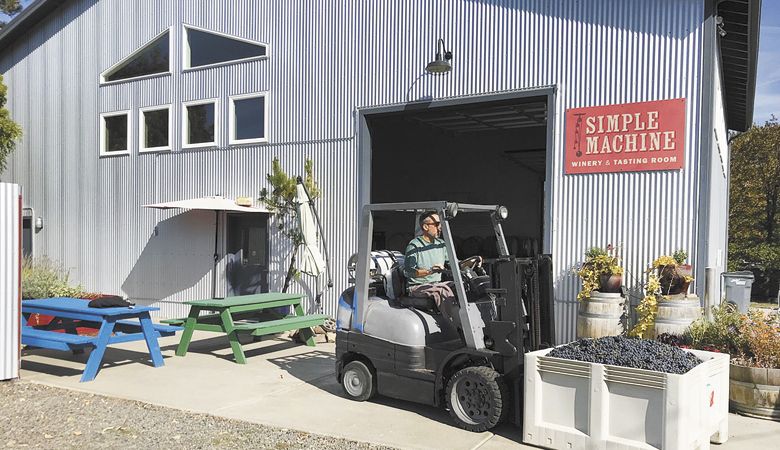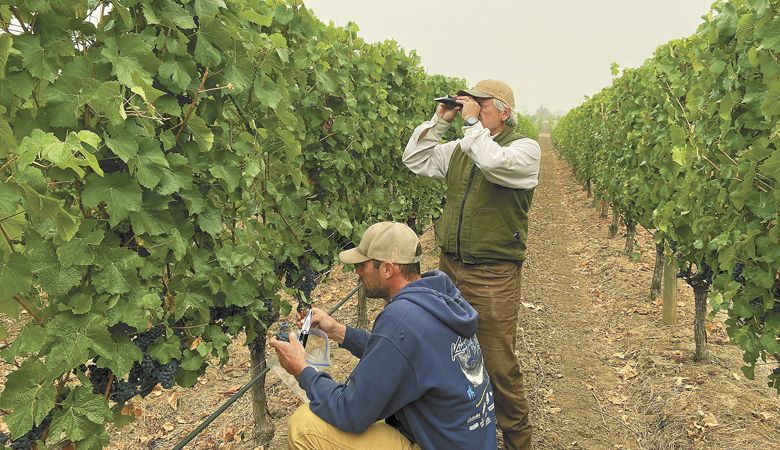Wildfire Impacts
Talent winery incinerated; industry assesses smoke effects on hanging fruit
By Paul Omundson
Many Oregonians, glancing up at the sky on Labor Day, won’t soon forget what they saw. A mostly sunny, clear afternoon suddenly transformed into a dark, menacing cauldron of smoke and ash, fueled by 38 separate blazes that swept into our midst, whipped around by intense winds. Dry forests provided ample tinder for this abrupt explosion of sparks and smoke.
Dense smoke smothered the state for two weeks. It caused stinging eyes and coughing in humans and still to be determined effects on wine grapes, some of which were just reaching optimum ripeness for harvest when smoke started choking the skies.
To date, there’s been only one significant wine-related structural damage report: Simple Machine Winery. The Rogue Valley winery in the town of Talent burned to the ground with all inventory destroyed — some 30 barrels and 12,000 bottles of wine.
Colleagues in the wine industry felt far more concerned about the welfare of Brian Denner and his crew at Simple Machine than smoke and ash on the skins of grapes. Rogue Valley allies went into action. Brian Gruber of Barrel 42 in Medford, five miles from Talent, led a drive to get area growers to donate fruit to the affected winery. So far, the response has been overwhelming. “We’re expecting nearly 20 tons of donated fruit here by the start of October,” he said.
Denner will now make his wine at Barrel 42, courtesy of Gruber and his co-partners Herb Quady and Nicole Schulte. They’re already up to four fermentations in their new temporary quarters. When Simple Machine staff can’t be on premises, Barrel 42 staff will tend to their barrels.
Denner continues receiving equipment donations, fruit and barrels from wineries all over the Rogue Valley.
Customers are doing their part, too. To generate cash for survival, Denner is conducting pre-sales for a number of wines his group is making to be released in spring and later. Response from fans has been immediate and heartwarming.
In addition to looking out for one another, Oregon wineries are concentrating on the safety and welfare of field workers, who were just beginning harvest when smoke became another major issue. Stringent COVID-19 safety precautions were already in place but suddenly the challenge switched to smoke. Some vineyards and wineries stopped harvest activity altogether until skies cleared. Others wore their usual masks for virus safety and additional coverings for smoke. In Southern Oregon, the Asante Foundation and La Clinica donated special N95 masks designed to protect those working in smoky environments.
Once-in-a-generation event
“Prior to Labor Day, the few fires Oregon had were starting to be brought under control,” climatologist Greg Jones told a virtual Zoom gathering of winemakers on Sept. 16 at an Oregon Wine Board (OWB) all-industry meeting. He described the atmospheric changes that brought humidity down to desert-like conditions, “even to the coast,” he emphasized. “With the onslaught of the strong winds and drying conditions, the small fires became large very quickly. The result was catastrophic fire developments across the state. This was unprecedented and a once-in-a-generation event.”
Labs backed up three weeks; now what?
The major challenge when harvest wraps up is determining if fruit has been impacted by two weeks of smoke. Since smoke affects the skin of the grape, it’s not hard to think that thin-skinned grapes would be more adversely affected. So is Oregon’s 2020 Pinot Noir harvest at risk? And, conversely, no worries for Cabernet Sauvignon?
“We just don’t know,” answered Jones. “More research has to be done.”
Aggravating the situation for growers now is the normal lab testing pipeline is currently backed up three weeks because of California fires. So plan B for many growers is to do their own small, micro-fermentations. “That’s your best way to determine if your grapes have been impacted by smoke,” suggested Elizabeth Tomasino, an Oregon State University researcher at the Sept. 16 session.
Another conference participant, Dr. Caroline Merell from Jackson Family Wines, has conducted 350 micro-fermentations on fruit and calls it the fastest way to evaluate fruit risk. She urged sample testing “block by block and at different elevations” for a comprehensive picture. She and Alisa Jacobson (Joel Gott Wines) shared their extensive micro-testing experience, supplying practical tips for growers on conducting the tests and interpreting results.
Look for more such events as the Oregon wine industry taps the expertise of the Australian Wine Research Institute and friends and colleagues in California; both areas have a history of dealing with smoke and wine grapes.
Sharpen our blades
Ariel Eberle, winemaker at Yamhill Valley Vineyards, remembered Oregon wine country’s last smoke encounter in 2017. “This is much more significant, just in the amount of time the smoke has hung around. I know we’ll need to amend our winemaking protocols,” she said. One of her new objectives this year will be limiting skin contact during grape management on the rosé of Pinot Noir. “I’ll be pressing off the skins quickly and gently, which minimizes the exposure to the compounds associated with smoke effect” she said. “There’s other approaches too, like making a more extracted red and utilizing new oak to enhance complexity that will, in turn, create more interest in the wine and match what the fruit of 2020 gives us. All in all, balance is the goal, neither to under or overmatch the fruit with winemaking but to find it’s complementary components. I’m going into this thinking it’s a great opportunity to learn, to try different things and experiment. Let’s sharpen our blades, share our findings with each other and apply it in the future.”
Ken Wright of Ken Wright Cellars has experienced smoky harvests before, as a former California vintner. He offers some reassurances: “We have 13 different vineyards in the Willamette Valley, and we go through each site, testing and tasting on a regular basis. So far, none have shown any evidence of smoke effect. Believe me, I know what smoke-affected grapes taste like — he compares them to “the “ashy remains of a campfire” — and I’ve not come on any indication of that.”
He added, “Our experience is that if you’re not near the source of the fire, it’s highly unlikely your fruit will be affected. We dodged a bullet since the nearest fire to us was in the Chehalem Mountains, about 15 miles away. Smoke from that far away doesn’t affect our fruit. There’s no need to worry about remote smoke.
“Danger comes,” Wright cautioned, “if your vineyard is close to the source or downwind from a fire. Otherwise, having smoke-affected fruit is unlikely.”
As harvest continues, definitive information on the extent of smoke impact will follow. It’ll be great data to apply to smoke preparation in future years.













